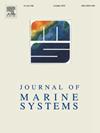Seasonal and mesoscale-eddy-caused variability in the Kuroshio surface current northeast of Taiwan differentiated using nine years of ocean radar observations
IF 2.5
3区 地球科学
Q2 GEOSCIENCES, MULTIDISCIPLINARY
引用次数: 0
Abstract
Seasonality and mesoscale eddies are the major sources of variability in the Kuroshio current northeast of Taiwan. Although previous studies have acknowledged these sources, none has differentiated their respective contributions. The surface current northeast of Taiwan was observed during 2001–2010 by a high-resolution spatiotemporal ocean radar system deployed on Ishigaki and Yonaguni Islands. We used the data from this system to differentiate between the contributions of the two sources of variability by comparing Kuroshio speed and path during different combinations of the phases of the two sources of variability: seasonality (summer or winter) and eddy type (anticyclonic or cyclonic). We found that the two sources of variability are independent. The period-averaged surface current structures for each combination of phases revealed two typical states for the Kuroshio. One is the “straight, fast” Kuroshio Current, which occurs when anticyclonic eddies arrive in summer (anticyclonic-summer phase) and the other is the appearance of the Kuroshio Branch Current, which happens when cyclonic eddies arrive in winter (cyclonic-winter phase). These typical Kuroshio surface current structures, revealed by classifying the phases of the sources of variability and conditions for their occurrence, should advance our understanding of the Kuroshio and its influences on the surrounding regions.
利用9年的海洋雷达观测,对台湾东北部黑潮表面流的季节和中尺度涡引起的变率进行了区分
季节性和中尺度涡旋是台湾东北黑潮变率的主要来源。虽然以前的研究已经承认了这些来源,但没有一个研究区分它们各自的贡献。利用部署在石垣岛和与那国岛的高分辨率海洋雷达系统,对2001-2010年台湾东北海面流进行了观测。我们使用该系统的数据,通过比较黑潮速度和路径在两种变率来源的不同阶段组合中的贡献来区分两种变率来源:季节性(夏季或冬季)和涡旋型(反气旋或气旋)。我们发现变异的两个来源是独立的。每个相组合的周期平均表面电流结构揭示了黑潮的两种典型状态。一个是“直、快”的黑潮,它发生在夏季反气旋涡旋到达时(反气旋-夏季相),另一个是黑潮支流的出现,它发生在冬季气旋涡旋到达时(气旋-冬季相)。这些典型的黑潮表面流结构,通过对变率来源的阶段和发生条件的分类,将有助于我们对黑潮及其对周边地区的影响的认识。
本文章由计算机程序翻译,如有差异,请以英文原文为准。
求助全文
约1分钟内获得全文
求助全文
来源期刊

Journal of Marine Systems
地学-地球科学综合
CiteScore
6.20
自引率
3.60%
发文量
81
审稿时长
6 months
期刊介绍:
The Journal of Marine Systems provides a medium for interdisciplinary exchange between physical, chemical and biological oceanographers and marine geologists. The journal welcomes original research papers and review articles. Preference will be given to interdisciplinary approaches to marine systems.
 求助内容:
求助内容: 应助结果提醒方式:
应助结果提醒方式:


